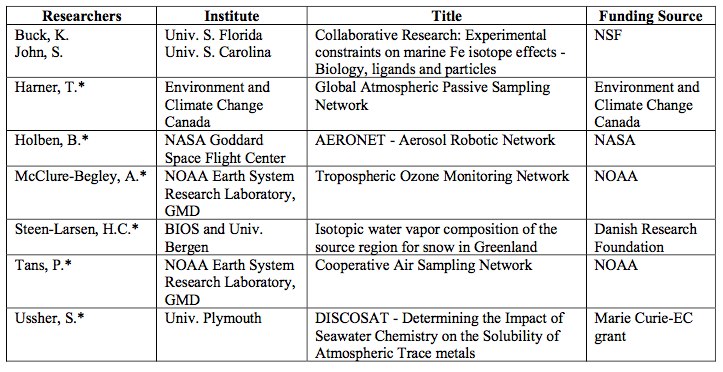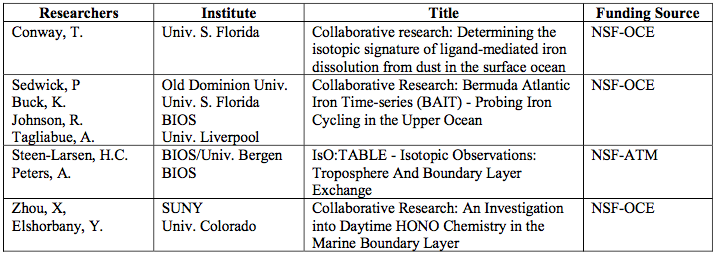Research Activities
Owing to its remote geographic location in the western North Atlantic, Bermuda has been a key sampling location for numerous studies of the marine atmosphere. This facility is one of only a few marine atmospheric observatories that exist worldwide and provides the ability to make year-round, complex measurements of the atmosphere over the ocean without the use of a research ship or buoy mooring.
Recent and Current Facility Users and Funding Sources

Prospective NSF-funded Facility Users for 2018-2021

Proposed Eddy Covariance Flux System
In recent years a great deal of work has been undertaken to better understand the oceanic production and entrainment of a number of important atmospheric gases (e.g. Wanninkhof et al., 2009; Iida et al., 2015; Couldray et al., 2016). This work has provided important insights into how the ocean may act as a source or a sink of these gases. A key tool of this type of research is the eddy covariance (EC) technique, a micrometeorological technique in which fluctuations in vertical wind velocity and the fluctuations in trace gas concentration are measured simultaneously in order to compute their covariance, i.e. their flux (Fairall et al., 2000; Miller et al., 2010; Prytherch et al., 2010; Baldocchi, 2014).
Thus the purchase and installation of a CO2 eddy covariance system at the Tudor Hill observatory is proposed to enhance the capabilities of the facility. The LI-7200RSF (LI-COR, Inc.) uses non-dispersive infrared spectroscopy to measure CO2 and H2O vapor densities in air. A 3-D sonic anemometer simultaneously records the three dimensional wind field, enabling gas fluxes to be computed.
Air-sea gas fluxes have traditionally been calculated using the gas transfer coefficient, k, representing the physical constraints of gas exchange, and ΔC, the bulk air-sea concentration difference. The typical approach has been to use wind speed to parameterize k. A major problem with this approach is that it is an indirect estimate that assumes k is governed solely by wind speed, despite mounting evidence that other parameters (e.g. phytoplankton production, presence of surfactants) are also important (Frew et al. 2004; Kock et al. 2012; Marandino et al. 2005, 2008; Wanninhkof et al. 2009). Application of the EC technique makes it possible to directly calculate k and determine how it changes as different measureable physical and biogeochemical parameters vary, thus enabling more robust models of gas fluxes to be developed.
Addition of this capability to the Tudor Hill Marine Atmospheric Observatory will supplement an identical system recently purchased by Damien Grundle (Assistant Scientist, BIOS) in 2017 and installed on the R/V Atlantic Explorer to undertake shipboard measurements of CO2 and its air-sea flux during regular monthly BATS cruises. Having the two systems will allow us to better examine localized v. far-field influences on atmospheric CO2 variability in the Sargasso Sea region of the Atlantic Ocean by measuring k over a range of spatial and temporal scales as different measureable physical and biogeochemical parameters vary. In this way, the THMAO will directly contribute to novel research work.
The EC flux technique will also be applied to the measurements of the isotopic signature of water vapor (H and O) currently undertaken at the facility (PI Steen-Larsen). These observations are made in real-time at high frequency using a cavity ring-down spectrometer. Interfacing this with the EC flux system will enable us to determine the isotopic signature of the water vapor flux over the ocean, as demonstrated by Good et al. (2012) for the terrestrial environment. This will build on substantive work already undertaken at the facility by Steen-Larsen and Peters by providing valuable data on the evaporative and precipitative flux of water over the Atlantic Ocean and insight on atmospheric mixing, transport and climate feedback processes (Benetti et al., in press).
The ability to study air-sea gas fluxes at Tudor Hill will be of appeal to a wider group of potential users. Other parameters for which fluxes have been determined using the EC technique and which could be exploited at the Tudor Hill facility include: heat, momentum, CH4, O3, methanol, DMS, and sea-spray aerosol (Pedreros et al., 2003; Marandino et al., 2007; Miller et al., 2009; Bariteau et al., 2010; Norris et al., 2012; Yang et al., 2013; Butterworth and Miller, 2016).
Proposed Aerosol Monitoring System
Aerosols are an important constituent of the atmospheric boundary layer. Aerosol particles provide surfaces for heterogeneous chemical processes, act as a condensation sink for atmospheric trace gases, serve as cloud and ice condensation nuclei, and also serve as a vector for the transfer of mass and energy between the oceans, land masses, and the atmosphere. Deposition of aerosols to the surface ocean can be a significant source of chemicals (e.g. nutrients and pollutants) to the ocean, and generation of sea spray aerosol at the air-sea interface has significant effects on global biogeochemical cycles (e.g. carbon cycling) and climate processes (e.g. cloud cover and albedo) (see Liss and Johnson, 2014, and references therein).
Aerosol sampling at Tudor Hill has been an integral component of operations at the facility since its establishment. This has most often been achieved as described in Section 5.5 above. While this is ideal for obtaining representative samples of bulk aerosol in the MBL using sectored sampling for subsequent chemical analysis (e.g. see Conte and Weber, 2002; Sholkovitz et al., 2010; Fishwick et al., 2014), it does not lend itself to the measurement of total aerosol mass loadings. This is a key parameter for determining total atmospheric burdens of aerosol constituents, and size-resolved data are essential for estimating atmospheric residence times and for modelling dry deposition and scavenging processes.
We therefore propose to purchase and install a continuous dichotomous ambient air monitor at the facility to provide real-time mass concentration measurements of aerosol. The TEOM 1405-DF monitor (Thermo Scientific) accounts for both non-volatile and volatile PM-10, PM-2.5 and PM-Coarse components. In addition to total mass loading, this will provide data on the relative contributions of primary aerosol particles (e.g. derived from sea salt and soil dust) and secondary particles (derived from condensation and chemical reaction processes). This instrument is currently used in locations in the Caribbean Basin and southern U.S. to monitor the transport of Saharan dust over the Atlantic Ocean (Prospero et al., 2014).
As with the proposed instrumentation for EC flux determinations described above, the acquisition of this instrument will significantly enhance the capabilities of the facility. The ability to monitor size- resolved mass concentrations of aerosols will allow us to better characterize the MBL at the location of Tudor Hill. In particular, we will be able to better analyze and interpret the potential for localized and distant contributions to the aerosol mass loadings, and to better discriminate when conditions may or not be truly representative of the open ocean MBL (see O’Dowd et al. (2014) for a thorough discussion of evaluating the representativeness of sampled aerosol in the MBL).


